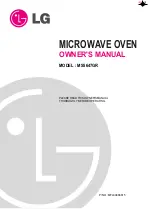
7
Introduction
Quantity of foods: The number of microwaves in your
oven remains constant regardless of how much food is
being cooked. Therefore, the more food you place in
the oven, the longer the cooking time. Remember to
decrease cooking times by at least one third when
halfing a recipe.
Shape of foods: Microwaves penetrate only about 1
inch (2.5cm) into foods, the interior portion of thick
foods are cooked as the heat generated on the outside
travels inward. In other words, only the outer edge of
any foods is actually cooked by microwave energy; the
rest is cooked by convection. It follows then that the
worst possible shape for a food that is to be
microwaved is a thick square. The corners will burn
long before the centre is even warm. Round thin foods
and ring shaped foods cook successfully in the
microwave.
Special Techniques In Microwave
Cooking
Browning: Meats and poultry that are cooked fifteen
minutes or longer will brown lightly in their own fat.
Foods that are cooked for a shorter period of time may
be brushed with a browning sauce to achieve an
appetizing colour. The most commonIy used browning
sauces are Worcestershire sauce, soy sauce and
barbecue sauce. Since relatively small amounts of
browning sauces are added to foods, the original
flavour of recipes are not altered.
Covering: A cover traps heat and steam which causes
food to cook more quickly. You may either use a lid or
microwave clingfilm with a corner folded back to
prevent splitting.
Covering with greaseproof paper: Greaseproofing
effectively prevents spattering and helps food retain
some heat. But because it makes a looser cover than
a lid or clingfilm, it allows the food to dry out slightly.
Wrapping in greaseproof or paper towel:
Sandwiches and many other foods containing
prebaked bread should be wrapped prior to
microwaving to prevent drying out.
Arranging and spacing: Individual foods such as
baked potatoes, small cakes and hors d’oeuvres will
heat more evenly if placed in the oven an equal
distance apart, preferably in a circular pattern. Never
stack foods on top of one another.
Stirring: Stirring is one of the most important of all
microwaving techniques. In conventional cooking,
foods are stirred for the purpose of blending.
Microwaved foods, however, are stirred in order to
spread and redistribute heat. Always stir from the
outside towards the centre as the outside of the food
heats first.
Turning over: Large, tall foods such as roasts and
whole chickens should be turned so that the top and
bottom will cook evenly. It is also a good idea to turn
cut up chicken and chops.
Placing thicker portions facing outwards: Since
microwaves are attracted to the outside portion of
foods, it makes sense to place thicker portions of
meat, poultry and fish to the outer edge of the baking
dish. This way, thicker portions will receive the most
microwave energy and the foods will cook evenly.
Shielding: Strips of aluminum foil, which block
microwaves, are sometimes placed over the corners or
edges of square and rectangular foods to prevent
those portions from overcooking. Never use too much
foil and make sure the foil is tightly secured to the dish
or it may cause ‘arcing’ in the oven.
Elevating: Thick or dense foods are often elevated so
that microwaves can be absorbed by the underside
and centre of the foods.
Piercing: Foods enclosed in a shell, skin or
membrane are likely to burst in the oven unless they
are pierced prior to cooking. Such foods include both
yolks and whites of eggs, clams and oysters and many
whole vegetables and fruits.
Testing if cooked: Because foods cook so quickly in
a microwave oven, it is necessary to test food
frequently. Some foods are left in the microwave until
completely cooked, but most foods, including meats
and poultry, are removed from the oven while still
slightly undercooked and allowed to finish cooking
during standing time. The internal temperature of
foods will rise between 5˚F(3˚C) and 15˚F(8˚C) during
standing time.
Standing time: Foods are often allowed to stand for 3
to 10 minutes after being removed from the microwave
oven. Usually the foods are covered during standing
time to retain heat unless they are supposed to be dry
in texture (some cakes and biscuits, for example).
Standing allows foods to finish cooking and also helps
flavour blend and develop.
Содержание MS5647GR
Страница 25: ......








































